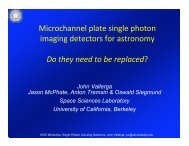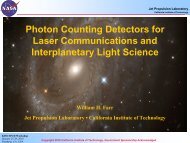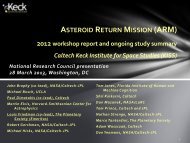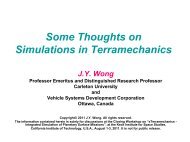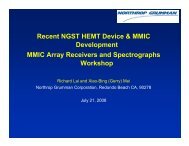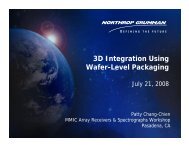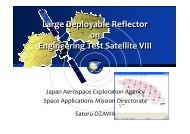Target NEO: Open Global Community NEO Workshop Report
Target NEO: Open Global Community NEO Workshop Report
Target NEO: Open Global Community NEO Workshop Report
You also want an ePaper? Increase the reach of your titles
YUMPU automatically turns print PDFs into web optimized ePapers that Google loves.
DRAFT: RELEASED FOR PUBLIC COMMENTOf the 765 NEAs that passed the Phase II trajectory filter, a total of 590 NEAs also satisfied thefurther constraint of maximum estimated size ≥ 30 m. The distributions of osculating heliocentricorbital semi-major axis (a), eccentricity (e), and inclination (i), for those 590 NEAs are shown inFigures 3(a) and 3(b). 2NHATS-Qualifying NEA Semilatus Rectums, AU1.51.41.31.21.110.90.80.7NHATS-Qualifying NEA Eccentricities0.450.40.350.30.250.20.150.10.05AtensApollosAmors0 5 10 15 20NHATS-Qualifying NEA Inclinations, degrees00.8 1 1.2 1.4 1.6 1.8 2NHATS-Qualifying NEA Semimajor Axes, AU(a) Semi-latus Rectum vs. Inclination(b) Eccentricity vs. Semi-major AxisFigure 3: Distribution of the 590 NHATS-Qualifying NEAs in Osculating (a, e,i) SpaceTo further our understanding of round-trip trajectory accessibility dynamics, it is instructive toexamine the distribution of the NHATS-Qualifying NEAs according to orbit classification. NEAsare grouped into four orbit families: Atiras (aphelion < 0.983 AU), Atens (aphelion > 0.983 AU,a < 1.0 AU), Apollos (perihelion < 1.017 AU, a > 1.0 AU), and Amors (1.017 < perihelion < 1.3AU).Of the 765 NEAs that satisfied the NHATS trajectory criteria, none are Atiras, 193 are Atens (31%of the known Atens), 456 are Apollos (11% of the known Apollos), and 116 are Amors (4% of theknown Amors). While Apollos make up 60% of the NEAs that pass the NHATS trajectory filterand Atens make up only 25%, the percentages according to orbit family are perhaps more relevant.Note that only 11% of the known Apollos passed the trajectory filter, while 31% of the knownAtens passed. These simple statistics alone strongly suggest that Aten orbits possess features thattend to enhance their round-trip trajectory accessibility as compared with Apollos or Amors. Thisis significant because Atens’ orbits cause them to spend considerable time in Earth’s daytime sky,making them difficult to discover and track using ground-based observing assets.3.2 <strong>NEO</strong> Mission Design ChallengesIt is important to note once again that the trajectory filter constraints utilized in the NHATSare purposely highly inclusive and therefore the NEAs that pass the NHATS filter arenot necessarily accessible for HSF. In fact, session proceedings identified multiple technical2 Note that the semi-latus rectum used in Figure 3(a) is equal to a`1−e2´.DRAFT: RELEASED FOR PUBLIC COMMENT 7




